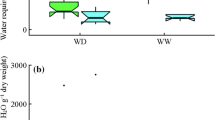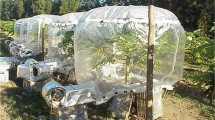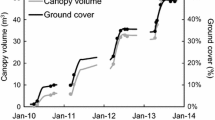Abstract
The rates of transpiration from a mature Eucalyptus globulus Labill. stand in Portugal were evaluated during a drying period of the spring-summer 1994. Transpiration was measured by the Granier sap flow method and estimated by the Penman-Monteith model. During the experimental period daily transpiration varied between 3.64 and 0.50 mm day−1. For high-transpiration days, a good agreement was observed between Penman-Monteith estimates and sap flow measurements, both on a daily and on an hourly basis. However, for low-transpiration days, the Penman-Monteith model overestimated transpiration in comparison with the sap flow method. The diurnal variation of sap flow was then smoother and lagged behind the estimates of the Penman-Monteith model. E. globulus showed an efficient control of transpiration losses during dry periods through a progressive stomatal closure. As soil moisture deficit increased, the daily maximum stomatal conductance decreased from 0.46 to 0.14 cm s−1. The results also show that, on a seasonal basis, stomatal conductance and daily transpiration were mainly related to predawn leaf water potential and, thus, to soil moisture content.
Similar content being viewed by others
Author information
Authors and Affiliations
Additional information
Received: 26 January 1996 / Accepted: 20 October 1996
Rights and permissions
About this article
Cite this article
David, T., Ferreira, M., David, J. et al. Transpiration from a mature Eucalyptus globulus plantation in Portugal during a spring-summer period of progressively higher water deficit. Oecologia 110, 153–159 (1997). https://doi.org/10.1007/PL00008812
Issue Date:
DOI: https://doi.org/10.1007/PL00008812




